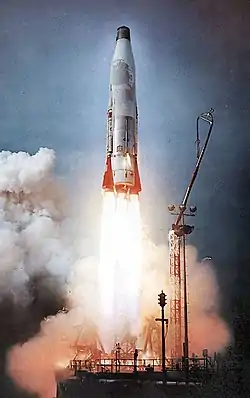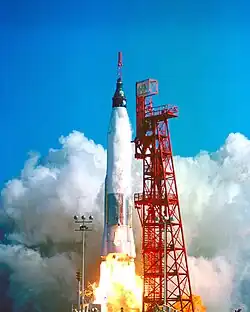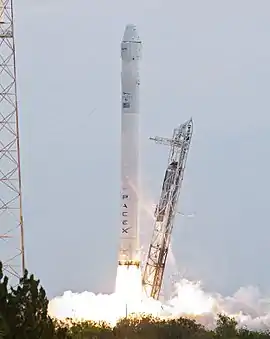Medium-lift launch vehicle
A medium-lift launch vehicle (MLV) is a rocket launch vehicle that is capable of lifting between 2,000 to 20,000 kg (4,400 to 44,100 lb) by NASA classification or between 5,000 to 20,000 kilograms (11,000 to 44,000 lb) by Russian classification[1] of payload into low Earth orbit (LEO).[2] An MLV is between small-lift launch vehicles and heavy-lift launch vehicles.
| Class overview | |
|---|---|
| Name | Medium-lift launch vehicle |
| Operators | Various space organizations |
| Preceded by | Small-lift launch vehicle |
| Succeeded by | Heavy-lift launch vehicle |
| Built | 1958– |
| Building | 7 |
| Active | 24 |
| Retired | 41 |
| General characteristics | |
| Propulsion | Various liquid-fueled engines and solid motors |
| Capacity |
|
Rated launch vehicles
Operational
| Vehicle | Origin | Manufacturer | Mass to LEO (kg) |
Mass to other orbits (kg) |
Launches | First Flight |
|---|---|---|---|---|---|---|
| Falcon 9 Block 5 | SpaceX | 17,400 reusable 22,800 expendable |
5,500 to GTO reusable 8,300 to GTO expendable 4,020 to Mars |
210 | 2018 | |
| Soyuz-2/Soyuz ST | TsSKB-Progress | 8,200 | 3,250 to GTO 4,400 to SSO |
164 | 2006[lower-alpha 1] | |
| Long March 4B/4C | SAST | 4,200 | 1,500 to GTO 2,800 to SSO |
101 | 1999 | |
| Atlas V | United Launch Alliance | 18,850 | 8,900 to GTO | 99 | 2002 | |
| Zenit-3 | Yuzhmash | 7,000 | 6,160 to GTO | 84 | 1999 | |
| Long March 2D | SAST | 3,500 | 1,300 to SSO | 83 | 1992 | |
| Long March 3B/E | CALT | 11,500 | 5,500 to GTO 6,900 to SSO |
79 | 2007 | |
| Long March 2C | CALT | 3,850 | 1,900 to SSO | 71 | 1982 | |
| PSLV | ISRO | 3,800 | 1,200 to GTO 1,750 to SSO |
59 | 1993 | |
| H-IIA | Mitsubishi | 10,000-15,000 | 4,100-6,000 to GTO | 46 | 2001 | |
| Long March 3A | CALT | 6,000 | 2,600 to GTO 5,000 to SSO |
27 | 1994 | |
| Long March 2F | CALT | 8,400 | 3,500 to GTO | 21 | 1999 | |
| Long March 3C | CALT | 9,100 | 3,800 to GTO 6,500 to SSO |
18 | 2008 | |
| GSLV | ISRO | 5,000 | 2,700 to GTO | 15 | 2010 | |
| Long March 7/7A | CALT | 13,500 | 5,500 to SSO 7,000 to GTO |
12 | 2016 | |
| Soyuz-2.1v | TsSKB-Progress | 2,800 | 1,400 to SSO | 9 | 2013 | |
| LVM 3 | ISRO | 10,000 | 4,000 to GTO | 7 | 2017[lower-alpha 2] | |
| Long March 6A | CALT | 4,500 to SSO | 3 | 2022 | ||
| Nuri | KARI | 3,300 | 1,900 to SSO (700 km) | 3 | 2022[lower-alpha 3] | |
| Long March 8 | CALT | 8,100 | 4,500 to SSO | 2 | 2020 | |
| Angara 1.2 | Khrunichev | 3,500[3] | 2 | 2022[lower-alpha 2] | ||
| Zhuque-2 | LandSpace | 6,000 | 4,000 to SSO (500 km) | 2 | 2022 | |
| Vega-C | Avio | 2,200 to SSO (700 km)[4] | 1 | 2022 | ||
| H3 | Mitsubishi Heavy Industries | 7,900 to GTO 4,000 to SSO |
1 | 2023 |
Under development
| Vehicle | Origin | Manufacturer | Mass to LEO (kg) |
Mass to other orbits (kg) |
Expected Flight |
|---|---|---|---|---|---|
| Ariane 6 (A62) | Arianespace | 10,350 | 5,000 to GTO | 2023 | |
| Irtysh | Progress Rocket Space Centre | 18,000 | 5,000 to GTO | 2025 | |
| Long March 10A | CALT | 14,000 | >2026 | ||
| Unified Launch Vehicle | Indian Space Research Organization | 4,500-15000 | 1,500-6000 to GTO | 2023 | |
| Neutron | Rocket Lab | 13,000 | 2024 | ||
| MLV | Firefly Aerospace | 14,000[5] | 2025 | ||
| Pallas-1 | Galactic Energy | 5,000 | 3,000 to SSO | 2024 |
Retired
| Vehicle | Origin | Manufacturer | Mass to LEO (kg) |
Mass to other orbits (kg) |
Launches | First Flight | Last Flight |
|---|---|---|---|---|---|---|---|
| Vostok | RSC Energia | 4,730 | 163 | 1958 | 1991 | ||
| Saturn I | Chrysler & Douglas | 9,000 | 10 | 1961 | 1965
long | ||
| Atlas-Centaur | Lockheed | 5,100 | 61 | 1962 | 1983 | ||
| Titan II GLV | Martin | 3,580 | 12 | 1964 | 1966 | ||
| Titan IIIC | Martin | 13,100 | 3,000 to GTO 1,200 to TMI |
36 | 1965 | 1982 | |
| Molniya-M | TsSKB-Progress | 2,400 | 280 | 1965 | 2010 | ||
| Proton-K | Khrunichev | 19,760 | 311 | 1965 | 2012 | ||
| Soyuz original | OKB-1 | 6,450 | 32 | 1966 | 1975 | ||
| R-36 Tsyklon | Yuzhmash | 2,820-5,250 (depends on variant)[6][7] | 500-910 to GTO[8] | 236 | 1967 | 2009 | |
| Soyuz-L | OKB-1 | 5,500 | 3 | 1970 | 1971 | ||
| Titan IIID | Martin | 12,300 | 22 | 1971 | 1982 | ||
| Soyuz-M | OKB-1 | 6,600 | 8 | 1971 | 1976 | ||
| Soyuz-U | TsSKB-Progress | 6,900 | 786 | 1973 | 2017 | ||
| Feng Bao 1 | Shanghai Bureau No.2 | 2,500 | 8 | 1973 | 1981 | ||
| Long March 2A | CALT | 2,000 | 4 | 1974 | 1976 | ||
| Titan IIIE | Martin Marietta | 15,400 | 3,700 to TMI | 7 | 1974 | 1977 | |
| Delta 3920–5920 | Douglas | 3,452–3,848 | 30 | 1980 | 1990 | ||
| N-II[9] | Mitsubishi | 2,000 | 8 | 1981 | 1987 | ||
| Soyuz-U2 | TsSKB-Progress | 7,050 | 72 | 1982 | 1995 | ||
| Atlas G | Lockheed | 5,900 | 7 | 1984 | 1989 | ||
| Long March 3 | CALT | 5,000 | 1,340 to GTO | 14 | 1984 | 2000 | |
| Zenit-2 | Yuzhnoye | 13,740 | 36 | 1985 | 2004 | ||
| H-I | Mitsubishi | 3,200 | 1,100 to GTO | 9 | 1986 | 1992 | |
| Long March 4A | SAST | 4,000 | 2 | 1988 | 1990 | ||
| Ariane 4 | Aérospatiale | 7,600 | 4,800 to GTO | 116 | 1988 | 2003 | |
| Delta II | United Launch Alliance | 6,100 | 2,170 to GTO 1,000 to HCO |
156 | 1989 | 2018 | |
| Atlas I, II, III | Lockheed | 5,900–8,686 | 2,340–4,609 to GTO | 80 | 1990 | 2005 | |
| Long March 2E | CALT | 9,200 | 7 | 1990 | 1995 | ||
| H-II / IIS | Mitsubishi | 10,060 | 4,000 to GTO | 7 | 1994 | 1999 | |
| Ariane 5 | Arianespace | 16,000 | 6,950 to GTO | 117 | 1996 | 2023 | |
| Long March 3B | CALT | 11,200 | 5,100 to GTO 5,700 to SSO |
12 | 1996 | 2012 | |
| Delta III | Boeing | 8,290 | 3,810 to GTO | 3 | 1998 | 2000 | |
| Dnepr | Yuzhmash | 4,500 | 2,300 to GTO 550 to TLI |
22 | 1999 | 2015 | |
| Soyuz-FG | TsSKB-Progress | 6,900 | 70 | 2001 | 2019 | ||
| GSLV Mk.I | ISRO | 4,000 | 2,150 to GTO | 6 | 2001 | 2010 | |
| H-IIB | Mitsubishi Heavy Industries | 19,000 | 8,000 to GTO | 9 | 2009 | 2020 | |
| Falcon 9 v1.0 | SpaceX | 10,450 | 4,540 to GTO | 5 | 2010 | 2013 | |
| Antares 110–130 | Orbital Sciences | 5,100[10] | 1,500 to SSO | 5 | 2013 | 2014 | |
| Falcon 9 v1.1 | SpaceX | 13,150 | 4,850 to GTO | 15 | 2013 | 2016 | |
| Falcon 9 Full Thrust
(before Block 5) |
SpaceX | 15,600+[11] | 7,075+[12] to GTO | 63 | 2015 | 2018 | |
| Antares 230 | Northrop Grumman | 8,000[10] | 3,000 to SSO | 13 | 2016 | 2023 |
- A suborbital test flight was conducted in 2004, without the upper stage.
- A suborbital test flight was conducted in 2014, without the upper stage.
- A flight in 2021 failed to reach orbit.
Gallery
 Launch of an Atlas B intercontinental ballistic missile
Launch of an Atlas B intercontinental ballistic missile Launch of the first American crewed orbital space flight Atlas and Friendship 7
Launch of the first American crewed orbital space flight Atlas and Friendship 7 A Falcon 9 v1.0 launches with an uncrewed Dragon spacecraft, 2012
A Falcon 9 v1.0 launches with an uncrewed Dragon spacecraft, 2012 Falcon 9 booster tank at the SpaceX factory, 2008
Falcon 9 booster tank at the SpaceX factory, 2008.jpg.webp) Launch of GSLV Mk lll D2 with GSAT-29 from SHAR, India.
Launch of GSLV Mk lll D2 with GSAT-29 from SHAR, India.
See also
- Sounding rocket, suborbital launch vehicle
- List of orbital launch systems
- Small-lift launch vehicle, capable of lifting up to 2,000 kg to low Earth orbit
- Heavy lift launch vehicle, capable of lifting between 20,000 and 50,000 kg to low Earth orbit. (Includes Ariane 5)
- Super Heavy lift launch vehicles, capable of lifting more than 50,000 kg (110,000 lb) of payload into LEO
- Comparison of orbital launch systems
- Comparison of orbital rocket engines
- Comparison of space station cargo vehicles
- Rocket
References
- Osipov, Yuri (2004–2017). Great Russian Encyclopedia. Moscow: Great Russian Encyclopedia.
- NASA Space Technology Roadmaps - Launch Propulsion Systems, p.11: "Small: 0-2t payloads, Medium: 2-20t payloads, Heavy: 20-50t payloads, Super Heavy: >50t payloads"
- "Angara Launch Vehicle Family". Khrunichev State Research and Production Space Center. Retrieved 2 September 2018.
- "Vega C". Retrieved 18 June 2021.
- "Medium Launch Vehicle". Firefly Aerospace. Retrieved 11 March 2023.
- "Tsiklon-2". Archived from the original on 27 December 2016.
- "Tsiklon-4". Encyclopedia Astronautica. Archived from the original on 22 August 2016. Retrieved 8 August 2016.
- "Tsyklon-4M (Cyclone-4M) prepares a move to Canada".
- "N-2". Encyclopedia Astronautica. Archived from the original on 8 November 2013. Retrieved 12 June 2013.
- Krebs, Gunter. "Antares (Taurus-2)". Gunter's Space Page. Retrieved 22 September 2018.
- "SpaceX and Cape Canaveral Return to Action with First Operational Starlink Mission". NASASpaceFlight.com. 11 November 2019. Retrieved 11 November 2019.
- Krebs, Gunter. "Telstar 19V (Telstar 19 Vantage)". Gunter's Space Page. Gunter. Retrieved 7 August 2018.
Further reading
- Mallove, Eugene F. and Matloff, Gregory L. The Starflight Handbook: A Pioneer's Guide to Interstellar Travel, Wiley. ISBN 0-471-61912-4.
This article is issued from Wikipedia. The text is licensed under Creative Commons - Attribution - Sharealike. Additional terms may apply for the media files.
.jpg.webp)

.jpg.webp)


